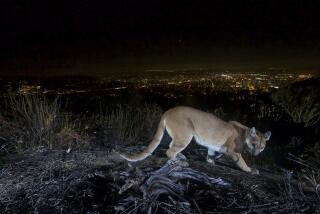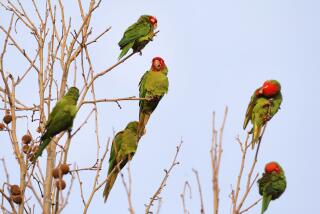L.A. Then and Now: Peacocks are one of Arcadia founder’s legacies
Elias J. “Lucky” Baldwin, the flamboyant founder of Arcadia, was no stranger to controversy. When pushing for cityhood in 1903, he was accused of illegally inflating population figures. Others claimed he wanted to create a city only for the purposes of “ribaldry, racing, gambling and gaming.”
And then there was his love life. A womanizer who married four times, his extramarital exploits made for sensational headlines.
But who would have ever guessed that Baldwin’s antics could still make waves today, and that all the fuss would involve birds?
Peafowl, to be precise.
Today, hundreds of colorful peacocks, and drabber female peahens, roam the Los Angeles County Arboretum & Botanic Garden in Arcadia and surrounding neighborhoods. The high-volume birds are a source of joy to some and consternation to others, yet they all trace back to a few fowl Baldwin picked up on a trip to India around 1880.
In 1875, Baldwin purchased about 8,000 acres of land then known as Rancho Santa Anita for $200,000 and made it his home. He planted acres of fruit trees and grapevines and raised sheep, cattle, hogs and horses.
No one knows the exact number of peafowl Baldwin imported from India, but by the 1880s “there were some 50 of them on the ranch,” says Sandy Snider, a local historian and the co-author of “Arcadia: Where Ranch and City Meet.”
At least one source credits Baldwin with being the first to bring this exotic creature to the continental United States.
Peafowl may seem an odd choice for a ranch, but they were actually quite handy to have around. Not only did they kill snakes and keep the snail population at bay, “they were good watchdogs,” says Mitchell Hearns Bishop, a curator at the Arboretum. “If someone or something came around, like a bobcat, they would give their alarm call, which is loud and piercing.”
Back then, owning a peacock also was a status symbol. “In the late 1800s and early 1900s, it was quite fashionable with the well-to-do who had land to put various animals on their property that they found colorful, attractive or unique. And a peacock in display is certainly magnificent,” says Francine A. Bradley, a peafowl specialist at UC Davis. “There was a brag factor to it.”
Baldwin also had a soft spot for birds. By one account, he had a pet parrot that would hide in the trees when he left the ranch. When Baldwin returned, it would fly down from his perch, calling “Pa, Pa.” The only way someone could get fired from the ranch was to mistreat an animal, especially a peacock, according to Snider.
After Baldwin’s death in 1909 at age 81, his daughter Anita sold off parcels of the ranch, eventually selling the last 1,300 acres in 1936 to Harry Chandler of the Los Angeles Times. In 1947, the state and the county of Los Angeles jointly purchased 111 acres to create an arboretum around the heart of the old ranch. (Later the county purchased additional parcels, bringing the Arboretum’s total acreage to today’s 127.)
The peafowl, which had always roamed free on the ranch and had swelled in number, had less land to call their own. That’s probably when they began wandering off the Arboretum, Snider says.
Eventually, a few feathers got ruffled.
As it turns out, peafowl survive just fine in the wild. They were able to find plenty of food and lots of places to lay eggs and multiply. Today, they’re a regular sight on city streets. And since the Arboretum isn’t totally fenced in, they won’t be contained any time soon.
Tourists delight at them at the Arboretum, and Arcadia has even adopted the peacock as its official bird. But some residents find them a nuisance.
The two biggest complaints? “The noise and the droppings on driveways,” says Linda Garcia, the communications manager for Arcadia. They also eat residents’ gardens and have been known to attack shiny car fenders. To help residents cope, the city publishes a pamphlet with tips on how to keep the birds off their property (don’t feed them; they will return!) and how to plant peafowl-resistant flower beds.
Even the Arboretum once got tired of having so many peafowl around. In the early 1960s, it reduced the number from 350 to 200 by auctioning off birds for $5 to $10 each, according to Life magazine.
Some people on the Palos Verdes Peninsula can no doubt relate. They’ve got their own wild peafowl problem. Cities there have spent time, energy and money controlling the birds and placating both the pro- and anti- peafowl contingents.
How did they first get on the peninsula?
Here’s one story: Somewhere between 1916 and 1920, the then-owner of the peninsula, a banker named Frank Vanderlip, commented that the place was beautiful but too quiet. Shortly thereafter, six pairs of peafowl arrived at his home. The Vanderlip and Baldwin families had social and business ties, and the Baldwins supposedly sent over the birds.
However, Bradley’s research shows that Vanderlip received the peafowl from chewing gum magnate William Wrigley Jr.’s family on Catalina Island. Wrigley’s daughter sent them to Vanderlip as a birthday present.
So in this version, Baldwin is off the hook.
By the way, there are also wild peafowl in La Cañada Flintridge. But no one’s linked them to Lucky Baldwin. At least not yet.


